 W
WThe Battle of Amphipolis was fought in 422 BC during the Second Peloponnesian War between Athens and Sparta. It was the culmination of events that began in 424 BC with the capture of Amphipolis by the Spartans.
 W
WThe Siege of Athens and Piraeus was a siege of the First Mithridatic War that took place from Autumn of 87 BC to the Spring and Summer of 86 BC. The battle was fought between the forces of the Roman Republic, commanded by Lucius Cornelius Sulla Felix on the one hand, and the forces of the Kingdom of Pontus and the Athenian City-State on the other. The Greek Pontian forces were commanded by Aristion and Archelaus.
 W
WThe Battle of Marathon took place in 490 BC during the first Persian invasion of Greece. It was fought between the citizens of Athens, aided by Plataea, and a Persian force commanded by Datis and Artaphernes. The battle was the culmination of the first attempt by Persia, under King Darius I, to subjugate Greece. The Greek army decisively defeated the more numerous Persians, marking a turning point in the Greco-Persian Wars.
 W
WThe Battle of Plataea was the final land battle during the second Persian invasion of Greece. It took place in 479 BC near the city of Plataea in Boeotia, and was fought between an alliance of the Greek city-states, and the Persian Empire of Xerxes I.
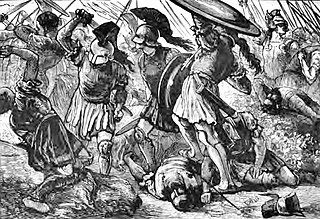 W
WThe Battle of Chaeronea was fought in 338 BC, near the city of Chaeronea in Boeotia, between the Macedonians led by Philip II of Macedon and an alliance of some of the Greek city-states led by Athens and Thebes. The battle was the culmination of Philip's final campaigns in 339-338 BC and resulted in a decisive victory for the Macedonians.
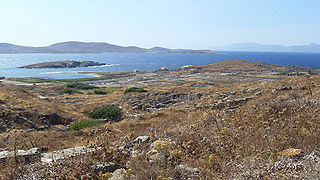 W
WThe Wars of the Delian League were a series of campaigns fought between the Delian League of Athens and her allies, and the Achaemenid Empire of Persia. These conflicts represent a continuation of the Greco-Persian Wars, after the Ionian Revolt and the first and second Persian invasions of Greece.
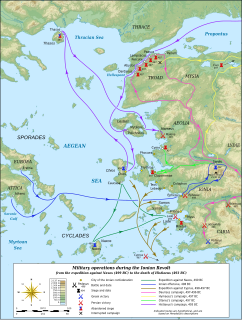 W
WThe Ionian Revolt, and associated revolts in Aeolis, Doris, Cyprus and Caria, were military rebellions by several Greek regions of Asia Minor against Persian rule, lasting from 499 BC to 493 BC. At the heart of the rebellion was the dissatisfaction of the Greek cities of Asia Minor with the tyrants appointed by Persia to rule them, along with the individual actions of two Milesian tyrants, Histiaeus and Aristagoras. The cities of Ionia had been conquered by Persia around 540 BC, and thereafter were ruled by native tyrants, nominated by the Persian satrap in Sardis. In 499 BC, the tyrant of Miletus, Aristagoras, launched a joint expedition with the Persian satrap Artaphernes to conquer Naxos, in an attempt to bolster his position. The mission was a debacle, and sensing his imminent removal as tyrant, Aristagoras chose to incite the whole of Ionia into rebellion against the Persian king Darius the Great.
 W
WThe Battle of Lechaeum was an Athenian victory in the Corinthian War. In the battle, the Athenian general Iphicrates took advantage of the fact that a Spartan hoplite regiment operating near Corinth was moving in the open without the protection of any missile throwing troops. He decided to ambush it with his force of javelin throwers, or peltasts. By launching repeated hit-and-run attacks against the Spartan formation, Iphicrates and his men were able to wear the Spartans down, eventually routing them and killing just under half. This marked one of the first occasions in Greek military history on which a force of peltasts had defeated a force of hoplites.
 W
WThe Second Battle of Mantinea was fought on July 4, 362 BC between the Thebans, led by Epaminondas and supported by the Arcadians and the Boeotian league against the Spartans, led by King Agesilaus II and supported by the Eleans, Athenians, and Mantineans. The battle was to determine which of the two alliances would have hegemony over Greece. However, the death of Epaminondas and his intended successors coupled with the impact on the Spartans of yet another defeat weakened both alliances, and paved the way for Macedonian conquest led by Philip II of Macedon.
 W
WThe First Battle of Mantinea of 418 BC was a significant engagement in the Peloponnesian War. Sparta and its allies defeated an army led by Argos and Athens.
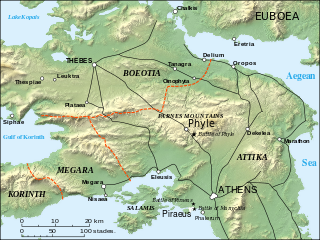 W
WThe Battle of Munychia was fought between Athenians exiled by the oligarchic government of the Thirty Tyrants and the forces of that government, supported by a Spartan garrison. In the battle, a substantially superior force composed of the Spartan garrison of Athens and the army of the oligarchic government attacked a hill in Piraeus which had been seized by 1,000 exiles under Thrasybulus, but was defeated. After this defeat, the Thirty Tyrants were forced to flee to Eleusis.
 W
WThe Battle of Nemea, also known in ancient Athens as the Battle of Corinth, was a battle in the Corinthian War, between Sparta and the allied cities of Argos, Athens, Corinth, and Thebes. The battle was fought in Corinthian territory, at the dry bed of the Nemea River. The battle was a decisive Spartan victory, which, coupled with the Battle of Coronea later in the same year, gave Sparta the advantage in the early fighting on the Greek mainland.
 W
WThe Battle of Olpae was a battle of the Peloponnesian War in 426 BC, between armies led by Athens and Sparta.
 W
WThe Siege of Perinthus was an unsuccessful attempt by Philip II of Macedon to defeat the Athenian forces at Perinthus, and take the city. The siege was conducted alongside an unsuccessful siege of Byzantium. Both sieges took place in the period just before the Fourth Sacred War.
 W
WThe Battle of Phyle was fought between Athenian exiles who were seeking to restore democracy to Athens and a Spartan garrison trying to protect the oligarchic Thirty Tyrants. In the battle, 700 Athenian exiles under Thrasybulus decisively defeated the Spartans and their Athenian cavalry in a dawn ambush.
 W
WThe Battle of Piraeus was fought in 403 BC between Athenian exiles who had defeated the government of the Thirty Tyrants and occupied Piraeus and a Spartan force sent to combat them. In the battle, the Spartans narrowly defeated the exiles, with both sides suffering appreciable casualties. After the battle, Pausanias arranged a settlement between the two parties which allowed the reunification of Athens and Piraeus, and the reestablishment of democratic government in Athens.
 W
WThe Battle of Potidaea was, with the Battle of Sybota, one of the catalysts for the Peloponnesian War. It was fought near Potidaea in 432 BC between Athens and a combined army from Corinth and Potidaea, along with their various allies.
 W
WThe Wars of the Delian League were a series of campaigns fought between the Delian League of Athens and her allies, and the Achaemenid Empire of Persia. These conflicts represent a continuation of the Greco-Persian Wars, after the Ionian Revolt and the first and second Persian invasions of Greece.
 W
WThe Sicilian Expedition was an Athenian military expedition to Sicily, which took place from 415–413 BC during the Peloponnesian War between the Athenian empire, or the Delian League, on one side and Sparta, Syracuse and Corinth on the other. The expedition ended in a devastating defeat for the Athenian forces, severely impacting Athens.
 W
WThe Battle of Spartolos took place in 429 BC between Athens and the Chalcidian League and their allies, in the early part of the Peloponnesian War.
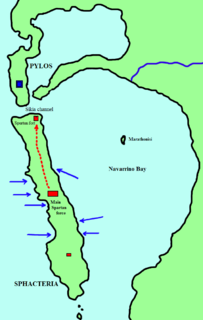 W
WThe Battle of Sphacteria was a land battle of the Peloponnesian War, fought in 425 BC between Athens and Sparta. Following the Battle of Pylos and subsequent peace negotiations, which failed, a number of Spartans were stranded on the island of Sphacteria. An Athenian force under Cleon and Demosthenes attacked and forced them to surrender.
 W
WThe Battle of Thermopylae was fought in 279 BC between invading Gallic armies and a combined army of Greek Aetolians, Boeotians, Athenians, and Phocians at Thermopylae. The Gauls under Brennus were victorious, and advanced further into the Greek peninsula where they attempted to sack Delphi but were completely defeated.